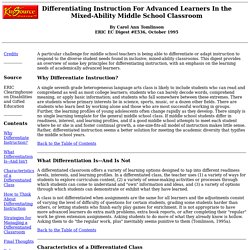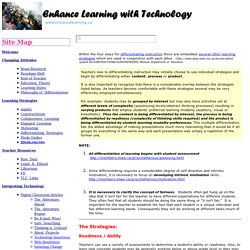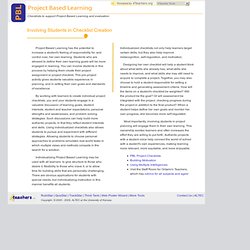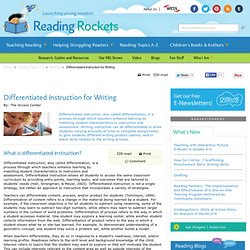

Differentiating Instruction For the Gifted. How to Think About Differentiating Instruction There are many ways to shake up the classroom to create a better fit for more learners-including those who are advanced.

In general, interest-based adjustments allow students to have a voice in deciding whether they will apply key principles being studied to math-oriented, literature-based, hobby-related, science-oriented, or history-associated areas. For example, in studying the American Revolution, one student might opt to write a short story about the life of a teenager during the Revolutionary period. Another might elect to apply key ideas about the American Revolution to an investigation of heroes then and now. Yet another might prefer to study ways in which the Revolution affected the development of science. Adjustments based on learning profile encourage students to understand their own learning preferences. Concrete to abstract. Advocates Say Differentiated Instruction Can Raise the Bar for All Learners. By Mary Anne Hess* A seventh grade boy spends his time in English class struggling to read at a beginner’s level.

A girl at a nearby desk with her nose in the book could probably tackle a Harvard literature class. Seated in between is a youngster who’s a whiz at math but takes a whole period to write three English sentences because he’s much more comfortable in his native Spanish. That’s diversity, as any educator knows, and — in one form or another — it’s always been a part of American education. "In the United States our goal is to educate all comers," says Dr. Many other countries cull the academic haves from the have-nots at various rungs on the education ladder. Teachers have faced this dilemma since the days of the one-room schoolhouse, which mixed 6- to 16-year-olds in the same space. "But our choice isn’t between sending them down the hall or doing nothing,” Tomlinson argues. Teachers Can Benefit "It’s more engaging for the teacher, too.
How Differentiation Works How? Carol A. Technology Articles. Within the four ways for differentiating instruction there are embedded several other learning strategies which are used in conjunction with each other.

The Strategies: Readiness / Ability Teachers can use a variety of assessments to determine a student's ability or readiness. Also, to learn new concepts students may be generally working below or above grade level or they may simply be missing necessary prerequisite skills. However, readiness is constantly changing and as readiness changes it is important that students be permitted to move between different groups (see flexible grouping). Assessment. Assessment "Assessment is the process of collecting information on student achievement and performance.

Assessment information provides the basis for sound decision making regarding teaching and learning. " "The assessment process reveals what a student understands, knows and can do. " Project Based Learning: Involving Students. Project Based Learning has the potential to increase a student's feeling of responsibility for, and control over, her own learning.

Students who are allowed to define their own learning goals will be more engaged in learning. You can involve students in this process by helping them create their project assignment or project checklist. This pre-project activity gives students valuable experience in planning, and in setting their own goals and standards of excellence. Project Based Learning Checklists. Administration. DI_UDL.1.14.11. Differentiated Instruction for Writing. What is differentiated instruction?

Differentiated instruction, also called differentiation, is a process through which teachers enhance learning by matching student characteristics to instruction and assessment. Differentiated instruction allows all students to access the same classroom curriculum by providing entry points, learning tasks, and outcomes that are tailored to students' needs (Hall, Strangman, & Meyer, 2003). Differentiated instruction is not a single strategy, but rather an approach to instruction that incorporates a variety of strategies.
Teachers can differentiate content, process, and/or product for students (Tomlinson, 1999). Differentiation of content refers to a change in the material being learned by a student. When teachers differentiate, they do so in response to a student's readiness, interest, and/or learning profile. How is it implemented? Implementation looks different for each student and each assignment. What does it look like for writing? Resources.